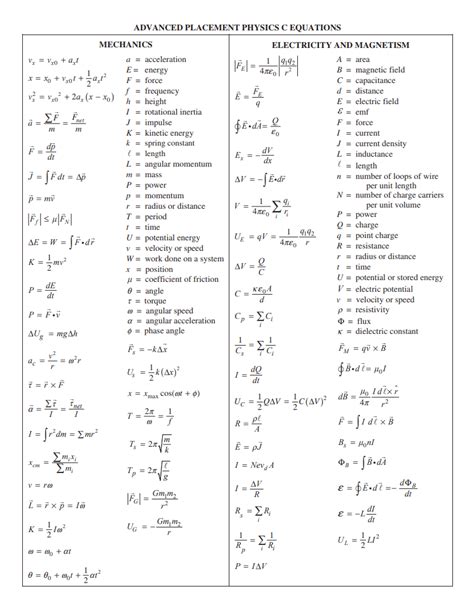The Physics C Equation Sheet is an essential tool for students taking the Advanced Placement (AP) Physics C: Mechanics and Physics C: Electricity and Magnetism exams. This sheet provides a concise list of the equations that cover the major topics tested on the exam. By understanding and applying these equations, students can effectively solve problems and demonstrate their mastery of physics concepts.

Key Equations
Mechanics
- Newton’s Laws of Motion:
- F = ma (force equals mass times acceleration)
- ΣF = 0 (net force equals zero)
-
F = ∆p/∆t (force equals change in momentum over change in time)
-
Work and Energy:
- W = Fd (work equals force times displacement)
- KE = 1/2mv^2 (kinetic energy equals half mass times velocity squared)
-
PE = mgh (potential energy equals mass times acceleration due to gravity times height)
-
Momentum:
- p = mv (momentum equals mass times velocity)
-
Σp = constant (total momentum in a closed system remains constant)
-
Rotational Motion:
- τ = rF (torque equals radius times force)
- Iω = constant (angular momentum remains constant)
Electricity and Magnetism
- Electric Charge and Field:
- F = kq1q2/r^2 (Coulomb’s law)
-
E = kq/r^2 (electric field due to a point charge)
-
Electric Current and Resistance:
- I = V/R (Ohm’s law)
-
P = IV (power dissipated in a resistor)
-
Magnetic Field and Force:
- B = µ0I/2πr (magnetic field due to a current-carrying wire)
-
F = qvB (magnetic force on a charged particle)
-
Electromagnetic Induction:
- ε = -dΦ/dt (electromotive force equals negative rate of change of magnetic flux)
- I = ε/R (induced current in a resistor)
Benefits of Using the Equation Sheet
- Enhanced Problem-Solving: The equation sheet serves as a quick reference for students, enabling them to recall the necessary equations during the exam.
- Improved Accuracy: By having the equations readily available, students can minimize errors and increase their chances of solving problems correctly.
- Time Management: The equation sheet eliminates the need for memorizing a large number of equations, allowing students to allocate more time to understanding and applying concepts.
- Reduced Anxiety: Having the equations at their fingertips can reduce anxiety and stress during the exam, enabling students to focus on the task at hand.
Tips for Effective Use
- Familiarize Yourself with the Equations: Before the exam, thoroughly review the equation sheet and understand the meaning and application of each equation.
- Practice Solving Problems: Use the equation sheet to practice solving a variety of problems to reinforce your comprehension and improve your problem-solving skills.
- Identify the Relevant Equations: During the exam, read the problem carefully to identify which equations are applicable.
- Substitute Values and Solve: Once you have identified the relevant equations, substitute the given values and solve for the unknown quantity.
Conclusion
The Physics C Equation Sheet is an invaluable resource for AP Physics C students. By understanding and applying the equations on this sheet, students can effectively solve problems, demonstrate their grasp of physics concepts, and improve their overall performance on the exam. With diligent preparation and practice, students can harness the power of the equation sheet to excel in their Physics C studies.
- AP Physics C: Mechanics and Electricity and Magnetism Exam Information
- AP Physics C Practice Questions
- Equations of Physics
| Mechanics Equations | Electricity and Magnetism Equations |
|---|---|
| F = ma | F = kq1q2/r^2 |
| ΣF = 0 | E = kq/r^2 |
| F = ∆p/∆t | I = V/R |
| W = Fd | P = IV |
| KE = 1/2mv^2 | B = µ0I/2πr |
| PE = mgh | F = qvB |
| p = mv | ε = -dΦ/dt |
| Σp = constant | I = ε/R |
| Rotational Motion Equations | Electromagnetic Induction Equations |
|---|---|
| τ = rF | ε = -dΦ/dt |
| Iω = constant | I = ε/R |
| Important Constants | Physical Units |
|---|---|
| k (Coulomb’s constant) = 8.99 x 10^9 N·m^2/C^2 | Mass (m) – kilograms (kg) |
| µ0 (Permeability of free space) = 1.26 x 10^-6 T·m/A | Length (d) – meters (m) |
| g (Acceleration due to gravity) = 9.81 m/s^2 | Time (t) – seconds (s) |
| e (Elementary charge) = 1.60 x 10^-19 C | Force (F) – Newtons (N) |
| Velocity (v) – meters per second (m/s) | |
| Acceleration (a) – meters per second squared (m/s^2) |
Applications of Physics C Principles
Mechanics:
– Designing bridges and buildings
– Modeling the motion of projectiles
– Analyzing the dynamics of sports and automotive vehicles
Electricity and Magnetism:
– Developing electrical circuits
– Generating and transmitting electricity
– Designing electronic devices and systems
– Harnessing electromagnetic waves for communication and imaging
Creative New Word for Applications
Phynovate – To apply physics principles in innovative ways to solve problems and develop new technologies.
Quotes
“Physics C is a gateway to understanding the fundamental forces that shape our world.” – Dr. James Gates, theoretical physicist
“The Physics C equation sheet is a powerful tool that empowers students to unlock the mysteries of the physical world.” – Dr. Lisa Randall, particle physicist
